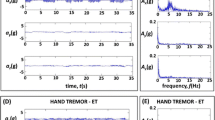Summary
A new method of prolonged recording of EMG provides a good estimate of spontaneous and induced diurnal variations in resting tremor in Parkinson's disease. It provides a record and a measure of the effects of treatment. Tremor intensity shows considerable variations even over short periods of time. Therefore short-term measurements of tremor are unhelpful. Long-term recordings agree better with the patient's assessment than with the clinical rating score. Repeated recordings over a similar 10-h period on 3 consecutive days in one patient showed fairly constant measures of occurrence and intensity of tremor. In contrast to accelerometer measurements of tremor, artefacts caused by movements and general activity of the patient do not materially interfere with tremor evaluation using surface EMG.
Similar content being viewed by others
References
Ackmann JJ, Sances A, Larson SJ, Baker JB (1977) Quantitative evaluation of long-term Parkinson tremor. IEEE Trans Biomed Eng BME-24:49–56
Bacher M, Scholz E, Diener HC (1988) 24 hours continuous tremor quantification based on EMG-recordings. Electroencephalogr Clin Neurophysiol 65 (in press)
Calzetti S, Baratti M, Gresty M, Findley L (1987) Frequency/amplitude characteristics of postural tremor of the hands in a population of patients with bilateral essential tremor: implications for the classification and mechanism of essential tremor. J Neurol Neurosurg Psychiatry 50:561–567
Cleeves L, Findley LJ (1987) Variability in amplitude of untreated essential tremor. J Neurol Neurosurg Psychiatry 50:704–708
Cleeves L, Findley LJ, Gresty M (1986) Assessment of rest tremor in Parkinson's disease. In: Yahr MD, Bergmann KJ (eds) Advances in neurology, vol 45. Raven, New York, pp 349–352
Dietrichson P, Engebretsen Ø, Fønstelien E, Hovland J (1978) Quantitation of tremor in man. In: Desmedt JE (ed) Physiological tremor, pathological tremors and clonus. Progress in clinical neurophysiology, vol 5. Karger, Basel, pp 90–95
Findley LJ, Gresty MA, Halmagyi GM (1981) Tremor, the cogwheel phenomenon and clonus in Parkinson's disease. J Neurol Neurosurg Psychiatry 44:534–546
Freund H-J, Hefter H, Hömberg V, Reiners K (1984) Differential diagnosis of motor disorders by tremor analysis. In: Findley LJ, Capildeo R (eds) Movement disorders: tremor. MacMillan, London, pp 27–35
Gresty MA, McCarthy R, Findley LJ (1984) Assessment of resting tremor in Parkinson's disease. In: Findley LJ, Capildeo R (eds) Movement disorders: tremor. MacMillan, London, pp 321–329
Halliday AM, Redfearn JWT (1956) An analysis of the frequencies of finger tremor in healthy subjects. J Physiol (Lond) 134:600–611
Hefter H, Hömberg V, Reiners K, Freund K-J (1987) Stability of frequency during long-term recordings of hand tremor. Electroencephalogr Clin Neurophysiol 67:439–446
Hömberg V, Reiners K, Hefter H, Freund HJ (1986) The muscle activity spectrum: spectral analysis of muscle force as an estimator of overall motor unit activity. Electroencephalogr Clin Neurophysiol 63:209–222
Hömberg V, Hefter H, Reiners K, Freund H-J (1987) Differential effects of changes in mechanical limb properties on physiological and pathological tremor. J Neurol Neurosurg Psychiatry 50:568–579
Jung R (1941) Physiologische Untersuchungen über den Parkinsontremor und andere Zitterformen beim Menschen. Z Ges Neurol Psychiatr 173:263–330
Koller WC (1986) Pharmacological treatment of parkinsonian tremor. Arch Neurol 43:126–127
Rack PMH, Ross HF (1986) The role of reflexes in the resting tremor of Parkinson's disease. Brain 109:115–141
Rondot P, Jedynak CP, Ferrey G (1978) Pathological tremors: nosological correlates. In: Desmedt JE (ed) Physiological tremor, pathological tremors and clonus. Progress in clinical neurophysiology, vol 5. Karger, Basel, pp 95–113
Struppler A, Erbel F, Velho F (1978) An overview on the pathophysiology of parkinsonian and other pathological tremors. In: Desmedt JE (ed) Physiological tremor, pathological tremors and clonus. Progress in Clinical Neurophysiology, vol 5. Karger, Basel, pp 14–128
Author information
Authors and Affiliations
Rights and permissions
About this article
Cite this article
Scholz, E., Bacher, M., Diener, H.C. et al. Twenty-four-hour tremor recordings in the evaluation of the treatment of Parkinson's disease. J Neurol 235, 475–484 (1988). https://doi.org/10.1007/BF00314251
Received:
Revised:
Accepted:
Issue Date:
DOI: https://doi.org/10.1007/BF00314251




